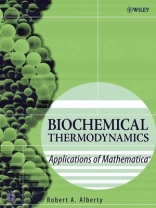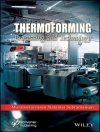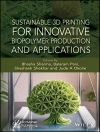Navigate the complexities of biochemical thermodynamics with
Mathematica(r)
Chemical reactions are studied under the constraints of constant
temperature and constant pressure; biochemical reactions are
studied under the additional constraints of p H and, perhaps, p Mg or
free concentrations of other metal ions. As more intensive
variables are specified, more thermodynamic properties of a system
are defined, and the equations that represent thermodynamic
properties as a function of independent variables become more
complicated.
This sequel to Robert Alberty’s popular Thermodynamics of
Biochemical Reactions describes how researchers will find
Mathematica(r) a simple and elegant tool, which makes it possible
to perform complex calculations that would previously have been
impractical. Biochemical Thermodynamics: Applications of
Mathematica(r) provides a comprehensive and rigorous treatment of
biochemical thermodynamics using Mathematica(r) to practically
resolve thermodynamic issues.
Topics covered include:
* Thermodynamics of the dissociation of weak acids
* Apparent equilibrium constants
* Biochemical reactions at specified temperatures and various
p Hs
* Uses of matrices in biochemical thermodynamics
* Oxidoreductase, transferase, hydrolase, and lyase reactions
* Reactions at 298.15K
* Thermodynamics of the binding of ligands by proteins
* Calorimetry of biochemical reactions
Because Mathematica(r) allows the intermingling of text and
calculations, this book has been written in Mathematica(r) and
includes a CD-ROM containing the entire book along with macros that
help scientists and engineers solve their particular problems.
विषयसूची
Preface.
Chapter 1: Thermodynamics of the Dissociation of Weak Acids.
Chapter 2: Introduction to Apparent Equilibrium Constants.
Chapter 3: Biochemical Reactions at Specified Temperature and
Various p Hs.
Chapter 4: Biochemical Reactions at Various p Hs and Various
Temperatures.
Chapter 5: Biochemical Reactions at Various p Hs, p Mgs, and
Various Temperatures.
Chapter 6: Development of a Database on Species.
Chapter 7: Uses of Matrices in Biochemical Thermodynamics.
Chapter 8: Oxidoreductase Reactions (Class 1) at 298.15 K.
Chapter 9: Transferase Reactions (Class 2) at 298.15 K.
Chapter 10: Hydrolase Reactions (Class 3) at 298.15 K.
Chapter 11: Lyase Reactions (Class 4), Isomerase Reactions
(Class 5), and Ligase Reactions (Class 6) at 298.15 K.
Chapter 12: Survey of Reactions at 298.15 K.
Chapter 13: Survey of Reactions at Various Temperatures.
Chapter 14: Thermodynamics of th Binding of Ligands by
Proteins.
Chapter 15: Calorimetry of Biochemical Reactions.
Appendix.
1. Basic Biochem Data3.nb.
2. Tables of Transformed Thermodynamic Properties.
3. Glossary of Names of Reactants.
4. Glossary of Symbols for Thermodynamic Properties.
5. List of Mathemutica Programs.
6. Sources of Biochemical Thermodynamic Information on the
Web.
Index.
लेखक के बारे में
ROBERT A. ALBERTY is the Emeritus Professor of Chemistry at
the Massachusetts Institute of Technology in Cambridge,
Massachusetts. Professor Alberty received a BS in 1943 from the
University of Nebraska, an MS in 1944 from the University of
Nebraska, and a Ph D in 1947 from the University of Wisconsin. He is
the author of Thermodynamics of Biochemical Reactions, also from
Wiley.












